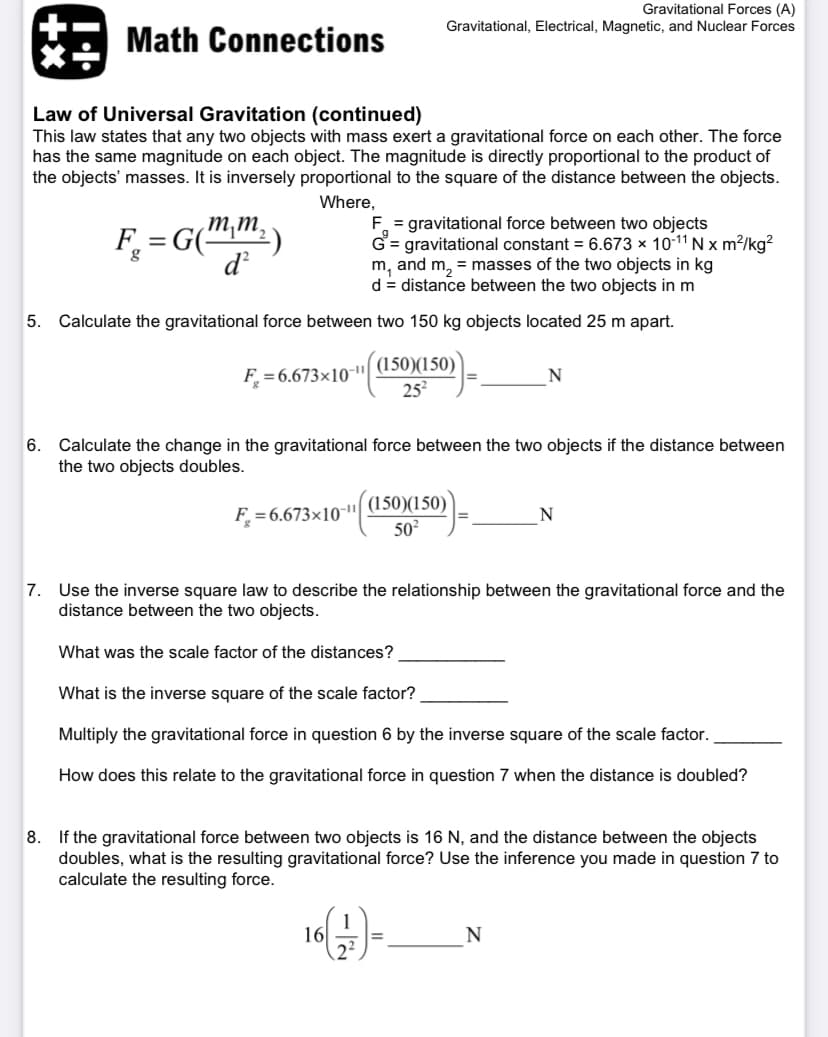5. Calculate the gravitational force between two 150 kg objects located 25 m apart. (150)(150) 25 F = 6.673x10- _N 6. Calculate the change in the gravitational force between the two objects if the distance between the two objects doubles. -" (150)(150) 50 F = 6.673×10 N 7. Use the inverse square law to describe the relationship between the gravitational force and the distance between the two objects. What was the scale factor of the distances? What is the inverse square of the scale factor? Multiply the gravitational force in question 6 by the inverse square of the scale factor. How does this relate to the gravitational force in question 7 when the distance is doubled?
5. Calculate the gravitational force between two 150 kg objects located 25 m apart. (150)(150) 25 F = 6.673x10- _N 6. Calculate the change in the gravitational force between the two objects if the distance between the two objects doubles. -" (150)(150) 50 F = 6.673×10 N 7. Use the inverse square law to describe the relationship between the gravitational force and the distance between the two objects. What was the scale factor of the distances? What is the inverse square of the scale factor? Multiply the gravitational force in question 6 by the inverse square of the scale factor. How does this relate to the gravitational force in question 7 when the distance is doubled?
Physics for Scientists and Engineers, Technology Update (No access codes included)
9th Edition
ISBN:9781305116399
Author:Raymond A. Serway, John W. Jewett
Publisher:Raymond A. Serway, John W. Jewett
Chapter13: Universal Gravitation
Section: Chapter Questions
Problem 13.10P: Review. A student proposes to study the gravitational force by suspending two 100.0-kg spherical...
Related questions
Topic Video
Question

Transcribed Image Text:Gravitational Forces (A)
Gravitational, Electrical, Magnetic, and Nuclear Forces
Math Connections
Law of Universal Gravitation (continued)
This law states that any two objects with mass exert a gravitational force on each other. The force
has the same magnitude on each object. The magnitude is directly proportional to the product of
the objects' masses. It is inversely proportional to the square of the distance between the objects.
Where,
F = gravitational force between two objects
= gravitational constant = 6.673 × 1011 N x m²/kg?
m, and m, = masses of the two objects in kg
d = distance between the two objects in m
m,m,
F, = G(
d
5. Calculate the gravitational force between two 150 kg objects located 25 m apart.
(150)(150)
25?
F = 6.673×10¯"
N
6. Calculate the change in the gravitational force between the two objects if the distance between
the two objects doubles.
F = 6.673x10-" (150)(150)
50?
7. Use the inverse square law to describe the relationship between the gravitational force and the
distance between the two objects.
What was the scale factor of the distances?
What is the inverse square of the scale factor?
Multiply the gravitational force in question 6 by the inverse square of the scale factor.
How does this relate to the gravitational force in question 7 when the distance is doubled?
8. If the gravitational force between two objects is 16 N, and the distance between the objects
doubles, what is the resulting gravitational force? Use the inference you made in question 7 to
calculate the resulting force.
16
N
Expert Solution
This question has been solved!
Explore an expertly crafted, step-by-step solution for a thorough understanding of key concepts.
This is a popular solution!
Trending now
This is a popular solution!
Step by step
Solved in 5 steps

Knowledge Booster
Learn more about
Need a deep-dive on the concept behind this application? Look no further. Learn more about this topic, physics and related others by exploring similar questions and additional content below.Recommended textbooks for you

Physics for Scientists and Engineers, Technology …
Physics
ISBN:
9781305116399
Author:
Raymond A. Serway, John W. Jewett
Publisher:
Cengage Learning

Physics for Scientists and Engineers: Foundations…
Physics
ISBN:
9781133939146
Author:
Katz, Debora M.
Publisher:
Cengage Learning

College Physics
Physics
ISBN:
9781938168000
Author:
Paul Peter Urone, Roger Hinrichs
Publisher:
OpenStax College

Physics for Scientists and Engineers, Technology …
Physics
ISBN:
9781305116399
Author:
Raymond A. Serway, John W. Jewett
Publisher:
Cengage Learning

Physics for Scientists and Engineers: Foundations…
Physics
ISBN:
9781133939146
Author:
Katz, Debora M.
Publisher:
Cengage Learning

College Physics
Physics
ISBN:
9781938168000
Author:
Paul Peter Urone, Roger Hinrichs
Publisher:
OpenStax College

University Physics Volume 1
Physics
ISBN:
9781938168277
Author:
William Moebs, Samuel J. Ling, Jeff Sanny
Publisher:
OpenStax - Rice University

Glencoe Physics: Principles and Problems, Student…
Physics
ISBN:
9780078807213
Author:
Paul W. Zitzewitz
Publisher:
Glencoe/McGraw-Hill
